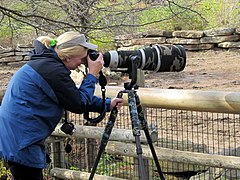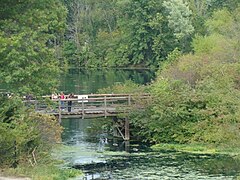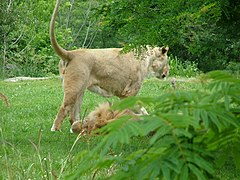Kansas City Zoo & Aquarium
| Kansas City Zoo & Aquarium | |
|---|---|
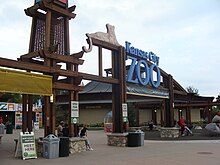 | |
 | |
| 39°0′25″N94°31′45″W/ 39.00694°N 94.52917°W | |
| Date opened | December 13, 1909 |
| Location | Swope Park Kansas City, Missouri,United States |
| Land area | 202 acres (82 ha)[1] |
| No.of animals | 1,700+ (Zoo)[1]and 8,000+ (Aquarium)[2] |
| Annual visitors | 1+ million[3] |
| Memberships | AZA[4] |
| Website | https://kansascityzoo.org |
TheKansas City Zoo & Aquariumis a 202-acre (82 ha) zoo founded in 1909 and is located inSwope Parkat 6800 Zoo Drive,Kansas City, Missouri,in the United States. The zoo has a Friends of the Zoo program to help promote the work of the zoo which sees over one million visitors a year. The zoo is home to nearly 1,700 animals and the aquarium has around 8,000 animals. The zoo is an accredited member of theAssociation of Zoos and Aquariums(AZA).
History
[edit]Planning for the zoo started in 1907, and its gates opened on December 13, 1909. The zoo evolved slowly during its first 40 years, while it added exhibits such as the Bear Grotto in 1912. It gained more momentum when it added a monkey island and a children's zoo in the 1940s. In the 1950s, the sea lion pool, African Veldt, giraffe house and flamingoes were all added; and the zoo added an otter pool, elephant house, and the Great Ape House in the 1960s. The early 1970s brought a dairy barn, the Great Catwalk andgibbonislands. Approximately twenty years later (in 1991), after voting and finances from a grant, the zoo expanded to the current size of 202 acres (82 ha), adding Australia in 1993, International Festival in 1994, and Africa in 1995. The opening of the Africa section drew in approximately 40,000 visitors in first 2 days.
The zoo would also build a new building to feature the firstIMAXin a zoo, the Sprint IMAX Theater. The improvements resulted in record attendance of 700,000 zoo guests and 400,000 IMAX visitors in 1998. The zoo has grown from a small building and 60 acres (24 ha) to a large, 202-acre (82 ha) zoo with over 1,300 animals. The Orangutan Primadome opened in 2002 as a part of new management when the zoo changed from a city-operated organization to a public-private partnership with Friends of the Zoo (FOTZfor short).
A 20-year plan plots the zoo's future, including new improvements. The Discovery Barn opened in 2006 along with a short-cut path to Africa. In 2006, the Kansas City Zoo was selected to become a breeding facility for African elephants and baboons. In 2007, an endangered species carousel was added to KidZone. The Zoo closed the Sprint IMAX Theater on September 4, 2007.[5]New admission gates to the zoo were opened in May 2008 featuring new parking and animals.
Extensive renovations of the zoo began in late 2005.[6]The Discovery Barn opened in 2006, formerly the Red Barn. It contains many exhibits and slides for children. Outside, there is a Peek-a-Boo Tree, that is fun for children to play in and get a sky-high view at the top of the tree, and like the Discovery Barn, it also contains a slide. The Promenade was also added in 2006, which is a wide path straight to the African elephants exhibit, which allows guests to reach Africa much faster. The new entrance admission gates opened in May 2008, with an educational center and a North American river otter and trumpeter swan exhibits. In early 2009, the Tropics House opened behind the Sea Lion pavilion in the 1909 Building and the polar bear exhibit opened in August 2010, located near the entrance, in the location formerly occupied by stroller rental.[7]In October 2013, the Helzberg Penguin Plaza opened, funded by an ongoing series of fundraising events as well as a 1/8th cent sales tax collected from the 2 county Zoological District.[8]In 2023 the $77 million Sobela Ocean Aquarium, which involved over 10 years of planning, opened to the public.[2]
Exhibits
[edit]The zoo is 202 acres (82 ha) and is home to more than 1,300 animals. It is located inSwope Park,the 29th largest municipal park in the United States. The zoo is divided into five areas of the following themes: Africa, Australia, Tiger Trail, KidZone and The Valley.
Front entry plaza
[edit]The admission gates and facilities (such as restrooms, gift shop, and food) are located in the entrance to the Kansas City Zoo. In 2010,polar bearswere re-introduced to the zoo near the existingNorth American river otterandtrumpeter swanpool just inside the World Gate. The entry plaza also features an educational center and stops for both the zebra tram and train.
Polar Bear Passage
[edit]
This exhibit opened on August 8, 2010, with the introduction of a polar bear named Nikita,[9]who was given to the Kansas City Zoo by theToledo Zoo.The $11 million exhibit features a 140,000 US gallons (530,000 L) pool serviced by a massive waterfall, multiple indoor and outdoor viewing angles with 2.25-inch-thick (57 mm) glass windows, and space for up to two additional polar bears.[1]In early-2013, a second polar bear was added to the exhibit, a female named Berlin, who was loaned to the zoo fromDuluth, Minnesota's Lake Superior Zoo in hopes that the two bears would breed.[10]In late-2015, Nikita was transferred from the zoo to theNorth Carolina Zoofor breeding purposes.[11]In late-2020, the zoo welcomed a new male polar bear named Nuniq, previously born atOhio'sColumbus Zoo and Aquariumin 2016 and living at theHenry Vilas ZooinMadison,Wisconsinbefore transferal.[12]
Africa
[edit]TheAfricasection is broken up into five subsections: Botswana, Kenya, Tanzania, the Congolese Rainforest, and Uganda. Several snack bars are located throughout Africa, as well as the Rafiki Restaurant and Equator gift shop in the Nanyuki Market (Kenya). Nanyuki Market also has a small aviary formasked lovebirdsand awhite-cheeked turaco.A zebra tram station and boat house are located in the Nanyuki Market. Tanzania features a pier for the boat ride on the other side of Africa.
Botswana
[edit]Botswanacontains nineAfrican bush elephants(eight female, one male) in an exhibit of 4.5 acres (1.8 ha) stretching 0.25 miles (0.40 km) with a water pool at one end. The elephants do paintings and demos during weekends. The elephant walk features a flamingo pool, home toChilean flamingos,black-necked swansand aPink-backed Pelican.The Promenade leads guests into Botswana and a large bridge then connects Botswana to the rest of Africa.
A male African elephant, Tamani fromBirmingham Zoo,(born atLowry Park Zooin 2005,) joined the zoo's then six older female elephants in October 2015 for socializing purposes, in hopes of pairing him with a younger female in the future.[13]Hogle Zoo's monther-daughter African elephant duo Christie (b. 1986) and Zuri (b. 2009) permanently moved into this habitat in October 2023.[14]
All 9 elephants at the zoo, and their origins, are as follows:
Christi (b. 1986, wild-born in Africa) fromHogle Zoo
Lady (b. 1968, wild-born in Africa) fromKings Island
Lea (b. 1978, wild-born in Zimbabwe)
Lois (b. 1978, wild-born in Zimbabwe)
Megan (b. 1978, wild-born inKruger National Park,South Africa) fromKings Island
Tamani (b. 2005, atLowry Park Zoo) fromBirmingham Zoo
Tattoo (b. 1978, wild-born in Africa) fromRiverbanks Zoo
Zoe (b. 1984, wild-born in Africa) fromCameron Park Zoo
Zuri (b. 2009, atHogle Zoo) fromHogle Zoo
Kenya
[edit]Kenyahascheetahs(with an observation building),warthog,and a deck with a view of somespringbok,lesser kudu,common eland,scimitar-horned oryx,andgray crowned cranesthat roam across an African plain.Saddle-billed storksandSouthern ground hornbillsmake up the wetland-themed exhibits on the opposite side of the walkway. At thebomaarea, replica huts simulate a Kenyan village which haslappet-faced vultureshoused withwhite-necked ravens,Aldabra tortoises,bateleur eagles,red-flanked duikers,andblue duikersare worked into small exhibits. The walk-through Scrubland Aviary is home to several species of birds, including awhite-cheeked turaco,white-faced whistling ducks,cattle egrets,abare-faced go-away-bird,marbled ducks,lilac-breasted roller,taveta weavers,superb starlings,and awhite-headed buffalo weaver,as well as side exhibits forred ruffed lemursandsilvery-cheeked hornbills.
Tanzania
[edit]
Tanzaniafeatures anAfrican lionexhibit with 9 lions visible from a climate controlled observation building as well as a covered deck. Small exhibits that appear carved or surrounded by rock simulate a naturalkopje;these includeserval,bushbaby,caracal,black-footed cat,rock hyrax,maskedandFischer's lovebird,bat-eared fox,andblack-throated monitor.A log-themed bridge crosses to theeastern black rhinocerosexhibit and a top-notch 3 acres (1.2 ha) enclosure housingchimpanzees.[15][page needed]The chimpanzee observation building allows guests to view a very large area for a troop of 12 chimps to play and explore, and allows visitors to become educated on chimpanzees with a connected classroom. This side of the African plains featuresMasai giraffes,Grant's zebras,gray crowned cranes,andostriches.Nearby are some ground birds,kori bustardandsecretary bird,leopard tortoises,a small house withWest African dwarf crocodiles,and ahippopool.
Uganda
[edit]Ugandasection has a small outdoor theater stage (Ruwenzori Theatre), and is home to spacious enclosures withAfrican wild dogsand a troop ofGuinea baboons,which sit adjacent to one another. A reservation-only campsite is located off into the woods from Uganda.
The Congolese Rainforest
[edit]TheCongolese Rainforestis located across a historic swinging bridge from Kenya. Animals on exhibit includered-capped mangabeyandblack mangabeyexhibits.Amur leopardsare featured in an exhibit with an overhead area which visitors walk under. A raised pathway crosses through exhibits containingbongo,gray crowned crane,red river hog,andyellow-backed duikerexhibits nestled in the dense forest. A single bachelorwestern lowland gorillaand a separate breeding group of one male and three female western lowland gorillas[15][page needed]can be viewed from a lookout building and from a renovated shelter with opportunities for up-close through-glass viewing.
Australia
[edit]
Australialies in the northernmost part of the zoo; there you can find a large field that is home to free-roamingred kangaroos.It features a walk-through Woodland Aviary, which includesblack swans,tawny frogmouth,straw-necked ibis,pied imperial pigeon,silver gull,smew,magpie goose,cockatiel,eclectus parrot,plumed whistling duck,long-billed corella,chestnut teal,wompoo fruit dove,Australian shelduck,white cockatoo,andsulphur-crested cockatoo.Beside the exit to the aviary is anemuexhibit. Also featured areparma wallaby,Bennett's wallaby,dingo,andMatschie's tree kangaroo.A replica of an Australian sheep farm features a farmer's home, a building with various animal hides and preserves,spotted python,green tree python,a pair oflaughing kookaburras,and a hands-onsheeppen. An exhibit withdromedary camelsis just past the sheep farm. Overlooking the kangaroo field is a train station and snack bar, and the final exhibit on the loop is an indoor exhibit for snakes of Australia.
It was announced in 2015 that the zoo would welcome a pair ofkoalasas a featured attraction in the summer of 2016.[11]
Tiger Trail
[edit]TheTiger Trailhas been home to many types of animals over the years; and recently, the area was renovated to center around the return of tigers to the Kansas City Zoo and its native Asia. The region of the zoo features oriental plants, lanterns, statues and various pictures of Asian animals. TheFrancois languris featured in the first enclosure. The path leads to a tunnel withBali mynahandred panda.The langurs and the pandas swap exhibits according to outdoor conditions (pandas are outside in fall and winter, while in tunnel during spring and summer). The focal point of the Tiger Trail is the critically endangeredSumatran tigerexhibit, which is home to two male tigers. Other animals on exhibit are thewreathed hornbilland thelion-tailed macaque.Near the former ape house, Asian waterfowl, such asred-crowned crane,Mandarin duck,andcommon shelduckcan be viewed in a wetlands exhibit.
Orangutan Canopy
[edit]After moving from the outdatedGreat ApeHouse in 2002, theBornean orangutanwere relocated to a new exhibit in Tiger Trail that featured a large outdoor "primadome." Originally intended only as a temporary home, work eventually began on August 17, 2014, on a $6 million neworangutanexhibit called Orangutan Canopy.[16]The Zoological District along with many donors helped make Orangutan Canopy possible. The 3,400 square foot exhibit, which houses six Bornean orangutans in a more naturalistic outdoor environment than their previous two enclosures offered, opened to the public in May 2015.[17]
KidZone
[edit]
TheKidZonearea features a large cage forrainbow lorikeets,with three daily feedings that guests may participate in. There is a largesea lionpool, which has several shows daily. The original 1909 building is located behind the sea lions, which has seen many renovations over the years and was most recently reopened in early 2009 as the Tropics House.
Discovery Barn
[edit]In theDiscovery Barn,scarlet macaw,green-winged macaw,White's tree frog,hourglass tree frog,squirrel monkey,marine toad,American toad,radiated tortoise,Prevost's squirrel,Linne's two-toed sloth,ring-tailed lemur,andpoison dart frogare housed alongside educational and fun features for children, including slides.
Tropics
[edit]
Tropicsis housed in the zoo's original building. The structure opened in summer 1909 and it was built at a cost of $32,000. It housed the zoo's entire collection. Originally known as the "Bird and Carnivora House", it featured a gabled roof heavily ornamented with architectural terra cotta and a large arching window. The gabled ends and eaves featured decorative carved stone bird heads – kingfishers, owls, and parrots. The original roof was removed in 1969 due to the badly deteriorating wooden framing. The building was closed in the 1990s, before reopening after a minor renovation in 2002. The building, used at that time for a traveling reptile exhibit, closed again in 2004 before undergoing much more extensive renovations. Following extensive renovation, the building reopened as Tropics in May 2009.[18]
In the Tropics House,saki monkeys,golden lion tamarin,white-cheeked gibbon,blue monkey,small-clawed otter,capybara,prehensile-tailed porcupine,mona monkey,Crested Porcupine,crested screamer,green aracari,andfreshwater stingrayare housed in a 13,000 square feet (1,200 m2) building. Exotic plant species and a vaulted glass roof for natural light are also included.[19]The enclosure's first birth came when Abby and Indigo, the zoo's blue monkey couple, welcomed their newborn baby on November 4, 2009.
Helzberg Penguin Plaza
[edit]
TheHelzberg Penguin Plazaopened on October 25, 2013. The 19,000 square feet (1,800 m2) facility features a 100,000 US gallons (379,000 L) cold water tank built for cold water penguins and a 25,000 US gallons (95,000 L) pool for warm weather penguins. Four species of penguins —king,gentoo,rockhopper,andHumboldt— are housed in the building alongside smaller aquarium exhibits featuring fish, jelly fish, and a coral reef display.
The Valley
[edit]TheValleyarea of the zoo opened in 1912, and it served as a primary portion of the zoo for many years. The first exhibits were a bear pit and a duck pond on the east side of the Valley. In 1914, agrizzly bearnamed Nemo was brought to the zoo fromYellowstone National Park.Nemo escaped from his enclosure in the Valley after bending the bars around his exhibit and scaling the rock bluff. The bear was eventually found 18 days later in a pool at a local cemetery.[20]
In 1932, theWorks Progress Administrationfunded a major expansion project in the Valley. The project was never fully completed, but it was used as a small grotto for smaller mammal exhibits. Through the years, the small grotto was home to various animals including Arctic foxes, hyenas, colobus monkeys,binturong,coatimundi,river otters,aardwolf,red pandas,maned wolves,white-tailed sea eagles and king vultures. Most of the structural work completed by the WPA remains intact, and the zoo planned to preserve the historical elements of the original 1912 bear pit, the 1932 WPA small grotto and Monkey Island by incorporating them into the construction of a new polar bear exhibit. Other issues with the location forced the new polar bear exhibit to be relocated to the Front Entry Plaza. The old structures in the Valley remain unused until a new development plan is announced that will incorporate their historically significant features.[20]
Monkey Island was the centerpiece of the Valley. The island was surrounded by a moat 20 feet (6.1 m) wide and 6 feet (1.8 m) deep. The Monkey Island exhibit opened in June 1946 withrhesus monkeys.Fifteen years after the exhibit opened, 30 mangabeys escaped. Many of the mangabeys were lured back to the exhibit with food; however, eleven remained loose for the entire summer until they were eventually captured as the weather began to turn cooler. Monkey Island was demolished in 1992 and replaced by a new exhibit for red pandas, musk deer, and maned wolf.[20]
Most of the Valley was closed in 2002 and it was entirely closed by 2005. Aflamingopond borders the outside edge of the valley and it remains in use. The old aviary row became Beaks and Feet Boulevard, with exhibits forIndian peafowl,green iguana,militaryandgreen-winged macaws,spectacled owl,Swainson's toucan,black-billed magpie,golden lion tamarin,red-handed tamarin,andbobcat.As of 2023, Beaks and Feet Boulevard has been removed, and most of the area is now taken up by the Sobela Ocean Aquarium, with the Chilean flamingo pond being the last remaining exhibit still in use from The Valley.
Great Ape House
[edit]
The zoo's formerGreat Ape Housewas a distinctive architectural landmark in Kansas City since it was completed in 1966. At the time of its construction, it was heralded as a modern marvel. The Great Ape house's distinctive mid-century design had been compared to structures in Disney'sTomorrowland,as well as theLiverpool Metropolitan Cathedral.In its earlier years, the ape house served as a central identity for the zoo, appearing on postcards and numerous zoo souvenirs.[21][22][23][24]At the time it was opened, the 55 feet (17 m) tall circular building was home to sevengibbons,fivechimpanzees,twoorangutansand twogorillas.
Eventually theapeswere all relocated to different areas of the zoo with only orangutans remaining in the exhibit by the time it was closed in 2003, with the opening of their new enclosure in Tiger Trail. Following its closure, supporters have pushed for its redevelopment for other uses due to its iconic architectural significance as a recognizable landmark. Discussion of the ape house's demolition began as early as 2001; however, the possibility of redevelopment has emerged as support for the zoo has increased dramatically since then. While it was still in operation, former zoo director Ernest Hagler suggested moving out the animals and turning the building into a gift shop or restaurant. It was never re-purposed and after sitting empty for over a decade, the building was ultimately demolished in September 2015, to make room for a new addition to the zoo, tentatively titled Predator Canyon.[25]As of 2023, the former site has been converted to the Outback Campground, which can be reserved for overnight events.[26]
Transportation
[edit]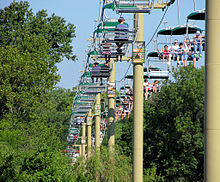
- Zebra Trams
A zebra-themed tram takes zoo guests along theAfrican elephantsandflamingos,from the World Gate to the African section of the zoo known as "Nanyuki Market" (in Kenya).
- Kansas City Zoo Railroad
A mini train takes visitors around the main area of the zoo with stops at World Gate and Australia.Dromedary camelsandkangarooscan be seen from the ride.
- Kenyan Cruise Boat Ride
A boat takes visitors (Memorial Day through Labor Day) for an up-close view of the African savannah animals, such as theMasai giraffe,lesser kuduandscimitar-horned oryx.Formerly known as theLake NakuruBoat Ride.
- African Sky Safari
A modified ski lift that goes over the middle of the Africa section from the marketplace to thechimpanzees.Riders may choose to ride a round-trip or get off on the other side. The Sky Safari opened to the public in the summer of 2011.[27]
Gallery
[edit]-
Professional photographer taking nature photos at the zoo.
-
Superb starling(Lamprotornis superbus).
-
Rhinoceros.
-
Inside the Tropics exhibit.
-
Blue monkey with newborn child in the Tropics exhibit.
-
Bridge walkway in one of the nature settings.
-
Hippopotamus.
-
Otter exhibit.
-
Lion and lioness at the zoo.
-
Carousel at the zoo.
Escapes
[edit]On February 19, 2012, two adultgorillasescaped from their enclosure when their door was accidentally left open. The gorillas were quickly captured after they wandered around the building they were housed in for a few minutes and no one was injured or threatened.[28]
On April 10, 2014, sevenchimpanzeesescaped from their enclosure when one of the animals used a log to scale the wall. The zoo was put on lockdown and visitors were kept safe inside designated buildings throughout the zoo until all seven chimpanzees had been returned to their exhibit.[29]
On May 29, 2019, an elephant escaped its enclosure after scaling a wall. It was returned to its enclosure safely within an hour.[30]
References
[edit]- ^abcMerlin, Lalla."Kansas City Zoo: transformation into a modern, conservation-focused attraction".Blooloop.
- ^abLjungblad, Tammy."Take a look inside the Sobela Ocean Aquarium, KC Zoo's new 'jewel' opening soon".McClatchy Media Network. The Kansas City Star.
- ^Bush, Jared."Kansas City Zoo to award their millionth visitor of the year".Nexstar Media Inc. FOX 4.
- ^ "Currently Accredited Zoos and Aquariums".aza.org.AZA.Retrieved26 June2011.
- ^Kansas City Zoo Press Release, "Kansas City Zoo Sprint IMAX© Theatre Closes September 4," August 28, 2007
- ^Kansas City Zoo Press Release, "Zoo Launches Most Aggressive Renovation in 10 Years," August 10, 2007
- ^Kansas City Star,June 10, 2008[dead link]
- ^Kansas City Zoo Marketing Department[when?]
- ^Kansas City Zoo Press Release, "A Big Celebrity Is Coming to Town," March 9, 2010
- ^nncnow,"Berlin the Polar Bear on Exhibit in Kansas City Zoo"Archived2013-04-10 at theWayback Machine,2013 January 17
- ^abMatt Campbell (June 24, 2015)."Kansas City Zoo is losing its male polar bear, Nikita".Kansas City Star.Archivedfrom the original on 2016-04-04.RetrievedMarch 27,2016.
- ^KMBC 9 News Staff (November 12, 2020)."Meet Nuniq! New male polar bear unveiled at Kansas City Zoo".KMBC Channel 9.Archivedfrom the original on 2020-12-02.RetrievedJune 6,2021.
{{cite web}}:CS1 maint: numeric names: authors list (link) - ^"Kansas City Zoo welcomes 9-year-old Tamani".5 October 2015.Archivedfrom the original on 2015-10-07.Retrieved2015-10-14.
- ^"Elephant Updates".
- ^abKansas City Zoo[when?]
- ^"Orangutan Canopy Ground Breaking | Kansas City Zoo".Archived fromthe originalon 2015-09-28.Retrieved2015-09-27.
- ^"New 'Orangutan Canopy' exhibit now open at the Kansas City Zoo | the Kansas City Star".Archivedfrom the original on 2015-09-30.Retrieved2015-09-27.
- ^"Taylor Kelly Renovates Kansas City Zoo's Original Main Building".Modern Builder.May–June 2009. pp1-2.
- ^KCTV5 News,July 2, 2008ArchivedMay 19, 2011, at theWayback Machine
- ^abc"Down in the Valley".Kansas City Zoo Expeditions.Winter 2013. pp14-16
- ^kawsmouth.com,"Palace of the Apes"Archived2014-09-03 at theWayback Machine,Lucas Wetzel, 2012 June 30
- ^Ljungblad, Tammy. "With KC Zoo's famed Great Ape House doomed, its remaining residents will soon leave view too."Kansas City Star.March 7, 2001. A1
- ^Hancocks, David.Animals and architecture.1971. p 144.
- ^Seeliger, Ruth.Kansas City Zoo Tales: A Wild 100-Year History.1999
- ^"Once iconic Great Ape House torn down at the Kansas City Zoo | the Kansas City Star".Archivedfrom the original on 2015-09-26.Retrieved2015-09-27.
- ^"Camp Out at the Zoo".Kansas City Zoo.Retrieved2 June2023.
- ^"Kansas City Zoo: African Sky Safari".17 June 2011.Archivedfrom the original on 2017-04-09.Retrieved2017-04-08.
- ^Campbell, Matt (February 20, 2012)."Keepers left doors unlocked before gorillas escaped at zoo".Kansas City Star.Archivedfrom the original on 2012-02-23.Retrieved2012-03-06.
- ^Burnes, Brian (April 10, 2014)."Seven chimpanzees use ingenuity to escape their enclosure at the Kansas City Zoo".Kansas City Star.Archivedfrom the original on 2015-01-09.Retrieved2014-08-31.
- ^Bill Smith (May 29, 2019)."'All clear' at the Kansas City Zoo after 'active code red' situation with elephant ".KCTV5 News.RetrievedMay 31,2019.
Further reading
[edit]- Seeliger, Ruth.Kansas City Zoo Tales: A Wild 100-Year History.Kansas City, Mo.: Kansas City Star Books.ISBN9781933466927.OCLC491447577.

